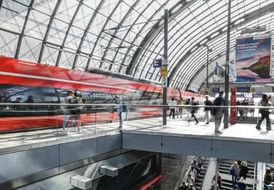Energy efficiency
Increasing energy efficiency is another component of achieving our climate protection target. In the short and medium term, we will also focus on the use of hybrid drives in our locomotives and multiple unit trains. In addition, we are continuously investing in the research and application of alternative drive systems and are taking an approach that is open to all technologies. Our measures to increase energy efficiency include, in particular, further electrifying our track infrastructure and reducing our energy consumption.
Specific primary energy consumption by DB Group journeys and transport | 2022 | 2021 | Change | 2020 | |
absolute | % | ||||
Regional rail passenger transport (MJ/pkm) | 0.83 | 1.37 | –0.54 | –39.4 | 1.29 |
in Germany | 0.82 | 1.34 | –0.52 | –38.8 | 1.23 |
Long-distance rail passenger transport (MJ/pkm) | 0.23 | 0.35 | –0.12 | –34.3 | 0.40 |
Bus transport (MJ/pkm) | 1.11 | 1.49 | –0.38 | –25.5 | 1.56 |
in Germany | 1.57 | 1.66 | –0.09 | –5.4 | 1.74 |
Rail freight transport (MJ/tkm) 1) | 0.28 | 0.30 | –0.02 | –6.7 | 0.29 |
in Germany | 0.26 | 0.28 | –0.02 | –7.1 | 0.28 |
Road freight transport (MJ/tkm) 2) | 1.22 | 1.23 | –0.01 | –0.8 | 1.26 |
Air freight (MJ/tkm) 3) | 9.17 | 9.29 | –0.12 | –1.3 | 9.06 |
Ocean freight (MJ/tkm) 3) | 0.08 | 0.07 | +0.01 | +14.3 | 0.07 |
Well-to-wheel (WTW); Scopes 1 –3; rail transport companies are included with their own electricity mix and/or European country mixes.
1) Up to and including 2020, excluding rail freight transport from/to China by DB Cargo and DB Schenker. Double accounting may be included in 2021, meaning that the values may be slightly higher.
2) Up to and including 2020, excluding pre-carriage and onward carriage from land, air and ocean freight.
3) Since 2021, excluding pre-carriage and onward carriage.
Train utilization in rail passenger transport has risen significantly again, but it remains below the pre-Covid-19 level. As a result, energy efficiency has improved due to the continued efficiency measures, but is still below the pre-Covid-19 level. We expect that the pre-Covid-19 level will be exceeded in the next few years as utilization continues to increase. Since DB Long-Distance rail passengers travel on 100% eco-power in Germany, DB long-distance rail passenger transport remained the most climate-friendly mode of transport in 2022. Further efficiency improvements were achieved in the logistics sector.
One effective lever for reducing our energy consumption in operation is, for example, equipping our locomotives with driver assistance systems such as LEADER at DB Cargo (2021 Integrated Report) and RESY at DB Regional, as well as buses with the Eco app at DB Regional (2021 Integrated Report), as these can have a positive effect on the driver’s driving behavior. We are modernizing our electric vehicle fleets by adding new series that achieve greater energy efficiency. In addition, our modern electric locomotives and multiple units make an important contribution to increasing the energy efficiency of the railway in Germany by supplying converted brake energy to the overhead wire. In 2022, the energy recovery rate increased noticeably to 17.9% (previous year: 16.7%). The fleet of vehicles equipped with recovery technology is growing, for example with the addition of further ICE 4 trains.
Stationary energy consumption
Absolute primary energy consumption of DB Group stationary facilities in Germany / TJ | 2022 | 2021 | Change | 2020 | |
absolute | % | ||||
Rail network operation | 5,128 | 5,600 | –472 | –8.4 | 6,086 |
Passenger stations | 2,519 | 2,640 | –121 | –4.6 | 3,693 |
Maintenance of rolling stock (facilities) | 2,978 | 2,539 | +439 | +17.3 | 3,007 |
Other | 3,182 | 4,157 | –975 | –23.5 | 4,145 |
Total | 13,807 | 14,936 | –1,129 | –7.6 | 16,931 |
By disclosing primary energy consumption, we also take into account the upstream processes involved in providing energy, such as the extraction, treatment and transport of fuels or processes for generating electricity. Our about 5,400 stations, interlockings and operating facilities, our depots and buildings in Germany, DB Schenker’s more than 2,100 locations worldwide and the DB Arriva and DB Cargo locations in other European countries account for 6.1% of DB Group’s total primary energy consumption. In order to continuously identify potential savings and sustainably reduce energy consumption and therefore greenhouse gas emissions, ten DB companies, including DB Energie GmbH, DB Regio AG, DB Fernverkehr AG and DB Station&Service AG, are currently operating a certified energy management system in accordance with DIN EN ISO 50001.
Due to the global energy crisis, DB Group has launched an initiative to save energy in the workplace. As an incentive to save energy and submit ideas, DB employees were paid an energy-saving bonus in December. We are also saving electricity thanks to the ongoing switch to LED lighting at stations. In 2022, the focus was on small and medium-sized stations.


